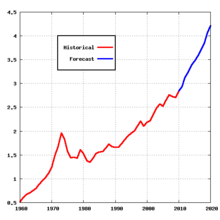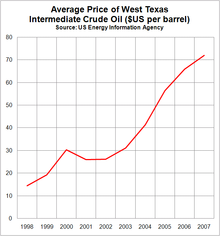- Oil reserves in Canada
-
Petroleum in Canada
This article is part of a series. 1. Early history
2. Story of natural gas
3. Oil sands and heavy oil
4. The frontiers
5. Gas liquidsResources and producers Oil reserves
Petroleum companiesCategories Oil fields
Oil refineries
Oil companiesEconomy of Canada
Energy policy of CanadaOil reserves in Canada were estimated at 179 billion barrels (28×109 m3) in 2007. This figure includes oil sands reserves which are estimated by government regulators to be economically producible at current prices using current technology.[1] According to this figure, Canada's reserves are third only to Venezuela and Saudi Arabia. Although the IEA insists on Canada's Reserves as being listed as 179 billion barrels, many experts including CEO of Shell Canada, Clive Mather estimate it to actually be two trillion barrels or more, essentially 8 times more than Saudi Arabia.[2] Over 95% of these reserves are in the oil sands deposits in the province of Alberta.[3] Alberta contains nearly all of Canada's oil sands and much of its conventional oil reserves. The balance is concentrated in several other provinces and territories. Saskatchewan and offshore areas of Newfoundland in particular have substantial oil production and reserves.[4] Alberta has 39% of Canada's remaining conventional oil reserves, offshore Newfoundland 28% and Saskatchewan 27%, but if oil sands are included, Alberta's share is over 98%.[5]
Status
Canada has a highly sophisticated energy industry and is both an importer and exporter of oil and refined products. In 2006, in addition to producing 1.2 billion barrels (190×106 m3), Canada imported 440 million barrels (70×106 m3), consumed 800 million barrels (130×106 m3) itself, and exported 840 million barrels (134×106 m3) to the U.S.[3] The excess of exports over imports was 400 million barrels (64×106 m3). Over 99% of Canadian oil exports are sent to the United States, and Canada is the United States' largest supplier of oil.[6]
The decision of accounting 174 billion barrels (28×109 m3) of the Alberta oil sands deposits as proven reserves was made by the Alberta Energy and Utilities Board (AEUB), now known as the Energy Resources Conservation Board (ERCB).[7] Although now widely accepted, this addition was controversial at the time because oil sands contain an extremely heavy form of crude oil known as bitumen which will not flow toward a well under reservoir conditions. Instead, it must be mined, heated, or diluted with solvents to allow it to be produced, and must be upgraded to lighter oil to be usable by refineries.[7] Historically known as bituminous sands or sometimes as "tar sands", the deposits were exposed as major rivers cut through the oil-bearing formations to reveal the bitumen in the river banks. In recent years technological breakthroughs have overcome the economical and technical difficulties of producing the oil sands, and by 2007 64% of Alberta's petroleum production of 1.86 million barrels per day (296,000 m3/d) was from oil sands rather than conventional oil fields. The ERCB estimates that by 2017 oil sands production will make up 88% of Alberta's predicted oil production of 3.4 million barrels per day (540,000 m3/d).[7]
Analysts estimate that a price of $30 to $40 per barrel is required to make new oil sands production profitable.[3] In recent years prices have greatly exceeded those levels and the Alberta government expects $116 billion worth of new oil sands projects to be undertaken between 2008 and 2017.[7] However the biggest constraint on oil sands development is a serious labor and housing shortage in Alberta as a whole and the oil sands centre of Fort McMurray in particular. According to Statistics Canada, by September, 2006 unemployment rates in Alberta had fallen to record low levels[8] and per-capita incomes had risen to double the Canadian average. Another hurdle has been Canada's capacity to rapidly increase its export pipelines. The National Energy Board indicated that exporters faced pipeline apportionment in 2007.[9] However, surging crude oil prices sparked a jump in applications for oil pipelines in 2007, and new pipelines were planned to carry Canadian oil as far south as U.S. refineries on the Gulf of Mexico.[10]
Canada is the only major oil producer in the Organization for Economic Co-operation and Development (OECD) to have an increase in oil production in recent years. Production in the other major OECD producers (the United States, United Kingdom, Norway and Mexico) have been declining, as has conventional oil production in Canada. But total crude oil production in Canada was projected to increase by an average of 8.6 percent per year from 2008 to 2011 as a result of new non-conventional oil projects.[11]
See also
References
- ^ EIA (2007). "International Energy Outlook 2007". Energy Information Administration of the U.S. Department of Energy. http://www.eia.doe.gov/oiaf/ieo/oil.html. Retrieved 2007-10-07.
- ^ Mather, Clive "The Oil Sands of Alberta", Canada Broadcasting Corporation,
- ^ a b c EIA (2007). "Country Analysis Brief: Canada". U.S. Energy Information Administration. http://www.eia.doe.gov/emeu/cabs/Canada/Oil.html. Retrieved 2007-10-07.
- ^ USask (2006) (DOC). Canadian frontier petroleum. University of Saskatchewan. http://www.usask.ca/geology/classes/geol463/463frontier.doc. Retrieved 2006-12-04.
- ^ NEB (May 2008). "Canadian Energy Overview 2007". National Energy Board of Canada. http://www.neb.gc.ca/clf-nsi/rnrgynfmtn/nrgyrprt/nrgyvrvw/cndnnrgyvrvw2007/cndnnrgyvrvw2007-eng.html#s4_4. Retrieved 2008-07-30.
- ^ EIA (2007-12-28). "Crude Oil and Total Petroleum Imports Top 15 Countries October 2007 Import Highlights: Released on December 28, 2007". Energy Information Administration of the U.S. Department of Energy. http://www.eia.doe.gov/pub/oil_gas/petroleum/data_publications/company_level_imports/current/import.html. Retrieved 2007-10-07.
- ^ a b c d ERCB (2008). ST98: Alberta's Energy Reserves 2007 and Supply/Demand Outlook 2008-2017. Alberta Energy Resources Conservation Board. http://www.ercb.ca/portal/server.pt/gateway/PTARGS_0_0_308_0_0_43/http%3B/ercbContent/publishedcontent/publish/ercb_home/publications_catalogue/publications_available/serial_publications/st98.aspx. Retrieved 2008-07-29.
- ^ Cross, Philip; Geoff Bowlby (September 2006). "The Alberta economic juggernaut" (PDF). Canadian Economic Observer. Statistics Canada. http://www.statcan.ca/english/ads/11-010-XPB/pdf/sep06.pdf. Retrieved 2006-12-05.[dead link]
- ^ NEB (July 2007). "Capacity constraints coming". 2007 Canadian Hydrocarbon Transportation System Assessment. National Energy Board of Canada. http://www.neb.gc.ca/clf-nsi/rthnb/nwsrls/2007/nwsrls23-eng.html. Retrieved 2007-08-14.
- ^ NEB (6 May 2008). "Surging crude oil prices sparked a jump in applications for oil pipelines in 2007". National Energy Board of Canada. http://www.neb.gc.ca/clf-nsi/rthnb/nwsrls/2008/nwsrls19-eng.html. Retrieved 2008-07-30.
- ^ Clavet, Frederic (February 2007). "Canada's Oil Extraction Industry: Industrial Outlook, Winter 2007". The Conference Board of Canada. http://www.conferenceboard.ca/documents.asp?rnext=1916. Retrieved 2007-04-01.
Oil reserves by country Listing List of countries by proven oil reservesCountries Canada · Cuba · Ghana · Iran · Iraq · Kuwait · Libya · Mexico · Nigeria · Russia · Saudi Arabia · United Arab Emirates · United States · VenezuelaCategories:- Petroleum production in Canada
- Economic history of Canada
- Oil companies of Canada
- History of Alberta
- Economy of Canada
- Oil fields of Alberta
- Bituminous sands of Canada
- Oil reserves by country
- Geology of Canada
Wikimedia Foundation. 2010.




